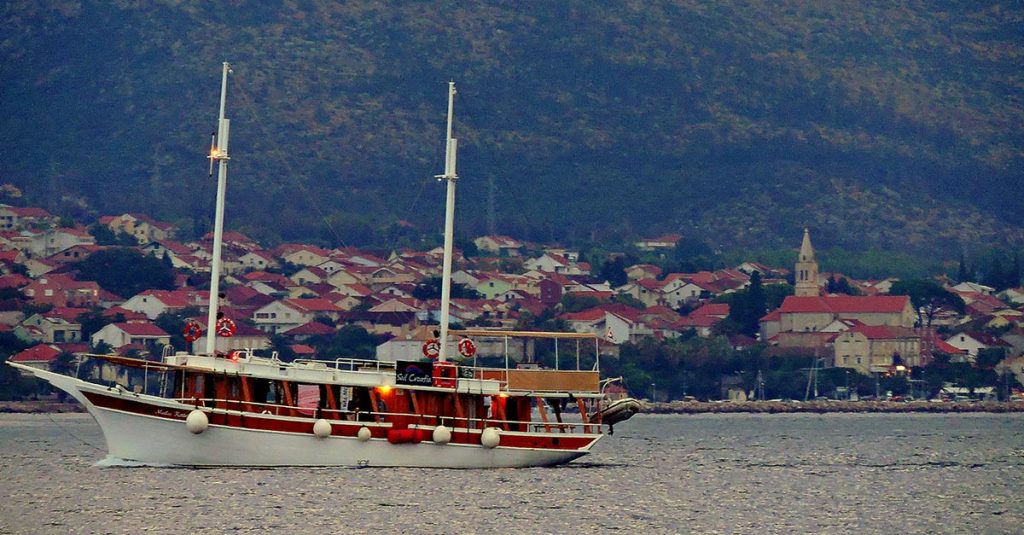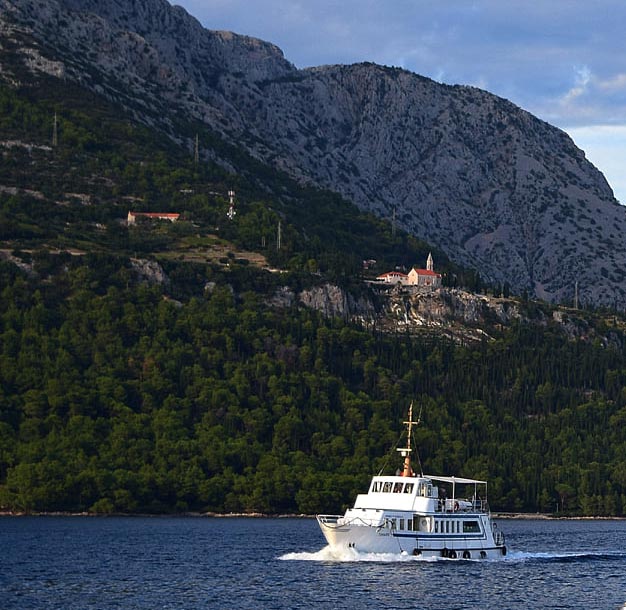Orebić
OREBIC or Orebici as it is called by its inhabitants takes its name from the XVIth century family of Peljesac captains. Definitely the most popular tourist resort on the Peljeska riviera.
It lies on the South Coast of the peninsula of Peljesac and at the East entrance to the Peljesac channel. It is two nautical miles from Korcula and can be reached by road from Dubrovnik and by the regular ferry and boat services from Korcula, (car ferry & passenger ferry) as well as during the half-day riviera cruise excursion organized by the Korcula travel agencies.
Exposed to the afternoon sunshine and facing South, Orebic offers a unique summer atmosphere, especially with its typical rows of captains houses, surrounded by the gardens of rich Mediterranean vegetation (pine, lemon, orange, and almond trees) and lined next to the sea.

Orebic is among the warmest Mediterranean holiday resorts both in terms of air temperature in C (January 9.1, April 15.0, July 26.5, October 18.6) and sea temperature (April 15.6, July 22,9 October 19.6). The Sveti Ilija (961 m) and Vizanjica (443 m) mountain range protect it from the “bura”, and they are themselves excursion points for hikers. The outline of the Italian coast can be seen from Sveti Ilija in clear weather. The coast of Orebic is full of small sand and pebble beaches, the biggest being Trstenica, which is 1500 m long.
Prehistoric menhirs and fortifications have been found in the vicinity of Orebiíc at Stine and Blace on the Vizanjica mountain. Remains of Roman Villae rusticae have also been discovered, and there is an especially valuable Early Christian marble relief above the doors of the porch of the Baroque church.
The Maritime Museum in Orebic and the art collections of the Fiskovic and Zupa families bear testimony to the rich history of Orebic and especially its large role in the development of seafaring on the Adriatic and on the Mediterranean.
Orebic experienced the golden days of its seafaring tradition in the XVIIIth and XIXth centuries. Between 1865 and 1887, it was the seat of one of the biggest shipping companies of that time – the “Associazione Marittima di Sabioncello” (AMS), this shipping company had 33 ships with Biblical names from the Old Testament and its capital was valued at 2 million Austrian gold forints. Their impressive wooden sailing ships, with their white sails, cruised through the Peljesac channel to all the seas, some of them even sailing to North America. In 1796, the sea captain Jozo Fiskovic made a voyage from the French port of Marseilles to Port Louis on the coast of Mauritius in the Indian Ocean.
Outstanding stone structures in Orebic are The Seaman’s Society Palace, the Seaman’s Museum Palace and the Palace of the Court. All of these buildings have a characteristic courtyard with stone columns and are surrounded by gardens.
Popular Routes: Split to Korcula, Korcula to Split, Dubrovnik to Korcula, Korcula to Dubrovnik
Orebic, our lady of angel
The greatest attraction of Orebic and a frequent excursion point for the people from Orebic and tourists is the church of Gospa od Angela (Our Lady of the Angels).

It can be reached by car, but the effort of walking there is rewarded by passing through tunnels of dense pine wood. It is situated on a craggy stone crest, 152 meters above the sea, and was built at the end of the XVIth century under the Dubrovnik Republic, to which Orebic belonged between 1333 and 1806. It was built by Franciscans in an ideal place, offering a bird’s-eye view of East, South, and West over the Korcula and Peljesac seas with the old town of Korcula in the background. Seamen passing under the monastery traditionally greet it with three whistles on their ship sirens, and the Franciscans answer with their church bells which produce an excellent sound.
Tourists listen with interest to these traditional whistles, feeling that they are participating in the life of this region. The dangerously attractive sounds of the Sirens in the Korcula and Peljesac caves which greeted the adventurous sailors in the distant mythological past have been replaced by the peaceful sound of church bells. But the monastery and church also had another role. The reconnaissance patrols of the Dubrovnik Republic could easily see the ports and shelters of the Venetian galleys in the vicinity of the old town of Korcula. They could then, riding on quick horses, notify Dubrovnik about any suspicious movement of ships towards the town of Dubrovnik. The lookouts were lined all along the stone slope, so the monastery also served as part of a defensive belt against pirates and other invaders which stretched from Orebic all along to Kucicte.
The Russian lord and travel writer, Petar Tolstoj, mentioned in 1868 the cypresses around the monastery cemetery. These cypresses meant a calm end to the captains from Orebic who ended their lives here after stormy tempests throughout the world. The items of greatest artistic value in the church are two marble relief of the “Gospa s djetetom” (Virgin and Child) one by the Florence sculptor Tomas Fiamberti and the other by Nikola Firentinac. from the middle of the XVth century and the other from the beginning of the XVIth century. The paintings on the main altar are also of special value “Gospino uznesenje” (Our Lady’s Ascension) and “Sveti Franjo” (Saint Francis) painted by master Maffeo de Verona in 1599 and “Poklonstvo kraljeva” (The Adoration of the Kings”) the work of the Madonists in the XVIIth century.
The monastery building consists of large one-floor house with four wings. It forms a unit with the church, dominated by the elegant bell tower. A loggia with a view of the Peljesac channel and a monastery alley are raised at the South-West part of the monastery building. The monastery also contains a Treasury with some valuable works of art. Of especial interest are the paintings of Sv. Franio Paolski (Saint Francis de Paula), the work of Francesco Lilli from Ancona. Crucifixes from the XVIIth century, silver crosses, Gothic sensers from the XVth and XVIth centuries, small silver oath plaque with a Peljesac sailing ship from the XVIIth century and china vases from the XIXth century are only a part of the rich art inheritance of this unique church and monastery “Gospa od Andela”
This fine architectonic whole is completed by an outside loggia on the edge of the high rock on the South side of the church. The loggia was built in the late Gothic and Renaissance styles at the beginning of the XVIth century. Similar loggias with porches were built in front of the churches of the nearby villages with the purpose of protecting the inhabitants from the heat and offering them the enjoyment of the view.
Many tourists, travel writers, musicians, painters, geographers, architects, historians, journalists and others brought here by professional curiosity or personal pleasure have written about this church complex and its surroundings. When the Austrian prince Philip of Koburg stayed here in 1905, hunting jackals from Asia Minor (“Caglji”), one of the zoological rarities of this region, he emphasized the beauty and uniqueness of the Franciscan monastery. The British writer, Seaton Watson, who was here in 1913, wrote that the view from the Franciscan monastery “Gospa od Andela” is one of the most beautiful in the world and that it could be compared with the view of the Turkish Principo group of islands in the archipelago of the Marble Sea. The French writer and director of a hotel chain on the Côte d’azur. M. Bouchet. remarks that beauty of the sunset here is unequaled else in the Mediterranean. Lews Collins, the President of the International Association for the Struggle Against Nuclear Experiments called the church with the Franciscan monastery “an unforgettable oasis of peace”.
The inhabitants of Orebic, inheritors of the rich seaman tradition, pay great attention to sports on the sea, especially sailing and fishing. The seaman-sport society ·Peliska Jedra· attracts sailing enthusiasts who frequently win at domestic and international regattas. They were also the initiators of the constructing of the marina in Orebic which can harbor 200 various sports vessels. The “Pelisac” hunting society organizes hunting trips on a wild high-quality game, especially moufflon brought from the Brioni Islands in 1970.
